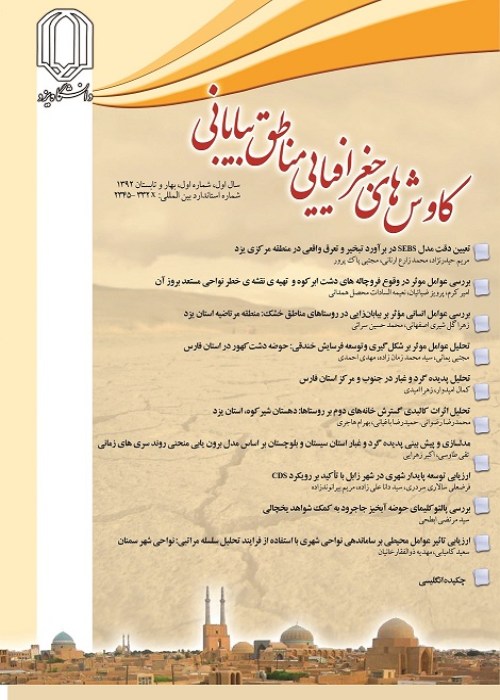Identifying the key factors in the future of sustainable urban regeneration: A case study of the inefficient urban tissues of District 14 in the city of Isfahan
Inefficient structures are part of the urban space that cause disorganization, imbalance, inequality, inefficiency and declining urban life. As the smallest cell and the most important factor in the sustainability of urban life, these structures play an important role in the urban future. Therefore, paying attention to the future perspective and planning for these places can lead to the stability of neighborhoods and the whole city. In recent years, urban planners and managers have turned their attention to sustainable planning through regeneration to address the problems faced by inefficient structures. Sustainable regeneration is a comprehensive and integrated approach to solving urban problems, leading to the continuous improvement of sustainable conditions in the physical, social, economic and environmental domains. The present study seeks to investigate the key factors affecting the sustainable regeneration of the dysfunctional texture in District 14 of Isfahan City.
The present research is applied in terms of purpose, descriptive-analytical in terms of research method, and, in terms of nature, based on new futuristic, analytical and exploratory methods. Data collection was done through a documentary-survey technique. To determine the variables, the Delphi method was used along with the opinions of experts. By snowball sampling method, 15 experts consisting of those in urban planning who were familiar with the study area were selected to respond. In this connection, the variables extracted from the documents and the variables obtained from the interview with experts were combined, and a set of variables was formed, which affected the future of sustainable reconstruction of dysfunctional tissue in District 14 including physical, social, economic, environmental and institutional dimensions. The variables were included in a questionnaire in the form of a 35 x 35 matrix to identify the interactions among them. Finally, matrix analysis was performed using the Mick Mac software.
The results of the study were based on a cross-impact matrix questionnaire that consisted of 1190 questions for 35 variables. Some variables were removed because they had no systematic and comprehensive effects. Depending on which area of the matrix the sum of the values of the matrix was located; five categories of variables could be identified. The method of distribution and the dispersion of variables in the scatter plot showed the degree of the system instability. According to the results obtained, out of 35 factors studied in this study, 16 factors were identified as key factors influencing the future of regenerating the dysfunctional texture in District 14. Out of those 16 factors, two were related to Zone 4 (independent variable). Due to the fact that the variables in this zone had a low impact, they were ignored according to the logic of the Mick Mac model and in order to simplify the planning process and focus on key variables. As a result, the 16 key factors found were provided to the group of experts in the form of a panel for screening. After re-screening, they were reduced to nine propulsive forces and considered as the final key factors.
Generally, nine key drivers were extracted as the main factors affecting the sustainable recreation of the study area. They included the immigration of foreign nationals, sanctions, inflation, financial crisis, attraction of domestic and foreign investments, expansion of the legal confines of District 14, stakeholder participation in urban decisions, planning the polar management style, tourist infrastructures and environmental sustainability. The results of this study showed that the variables defined in the economic domain have the greatest impact on the situation of he dysfunctional textures. Therefore, these variables have a significant advantage in terms of influencing other variables, and they can be introduced as key factors affecting the future of the sustainable regeneration of the dysfunctional texture in District 14. The recognition of the key factors makes it possible to deal with the problem of structural dysfunctionality. The findings of this study and what has been obtained from the existing theories about sustainable urban regeneration call for attention to inefficient urban structures with new approaches to sustainable urban regeneration. This can not only stabilize and improve the economic, social, physical and environmental conditions of those structures but also increase sustainability in metropolises. At present, most reconstructions ignore the social, economic and environmental dimensions and pay attention to the physical dimension. In this research, the perspective of regeneration is stable. In other words, if the four dimensions of sustainable regeneration are considered together in metropolises, it can lead the whole city toward sustainability. Otherwise, without considering these four dimensions together, we will see the continuation of the current unstable situation, which has a beautiful shape but is worn-out and inefficient inside.
- حق عضویت دریافتی صرف حمایت از نشریات عضو و نگهداری، تکمیل و توسعه مگیران میشود.
- پرداخت حق اشتراک و دانلود مقالات اجازه بازنشر آن در سایر رسانههای چاپی و دیجیتال را به کاربر نمیدهد.


